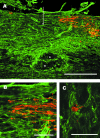NG2: a component of the glial scar that inhibits axon growth
- PMID: 16367799
- PMCID: PMC1571583
- DOI: 10.1111/j.1469-7580.2005.00452.x
NG2: a component of the glial scar that inhibits axon growth
Abstract
NG2 is a high-molecular-weight chondroitin sulphate proteoglycan found on the surfaces of oligodendrocyte precursor cells (OPCs). Here we review the history and biology of OPCs with an emphasis on their functions after experimentally induced CNS injury. Injury to brain or spinal cord results in the rapid accumulation of NG2-expressing OPCs in the glial scar that forms at the injury site. The glial scar is considered a biochemical and physical barrier to successful axon regeneration and the functional properties of NG2 suggest that it, along with other macromolecules, participates in the creation of this growth-inhibitory environment. NG2 is an important target for therapies designed to promote successful axon regrowth.
Figures





Similar articles
-
Inhibition of axon growth by oligodendrocyte precursor cells.Mol Cell Neurosci. 2002 May;20(1):125-39. doi: 10.1006/mcne.2002.1102. Mol Cell Neurosci. 2002. PMID: 12056844
-
Oligodendrocyte precursor cells: reactive cells that inhibit axon growth and regeneration.J Neurocytol. 2002 Jul-Aug;31(6-7):481-95. doi: 10.1023/a:1025791614468. J Neurocytol. 2002. PMID: 14501218 Review.
-
Evidence that perinatal and adult NG2-glia are not conventional oligodendrocyte progenitors and do not depend on axons for their survival.Mol Cell Neurosci. 2003 Aug;23(4):544-58. doi: 10.1016/s1044-7431(03)00176-3. Mol Cell Neurosci. 2003. PMID: 12932436
-
Mixed primary culture and clonal analysis provide evidence that NG2 proteoglycan-expressing cells after spinal cord injury are glial progenitors.Dev Neurobiol. 2007 Jun;67(7):860-74. doi: 10.1002/dneu.20369. Dev Neurobiol. 2007. PMID: 17506499
-
Polydendrocytes: NG2 cells with many roles in development and repair of the CNS.Neuroscientist. 2007 Feb;13(1):62-76. doi: 10.1177/1073858406295586. Neuroscientist. 2007. PMID: 17229976 Review.
Cited by
-
Role of the lesion scar in the response to damage and repair of the central nervous system.Cell Tissue Res. 2012 Jul;349(1):169-80. doi: 10.1007/s00441-012-1336-5. Epub 2012 Feb 25. Cell Tissue Res. 2012. PMID: 22362507 Free PMC article. Review.
-
The Significance of Chondroitin Sulfate Proteoglycan 4 (CSPG4) in Human Gliomas.Int J Mol Sci. 2018 Sep 12;19(9):2724. doi: 10.3390/ijms19092724. Int J Mol Sci. 2018. PMID: 30213051 Free PMC article. Review.
-
Understanding the Role of the Glial Scar through the Depletion of Glial Cells after Spinal Cord Injury.Cells. 2023 Jul 13;12(14):1842. doi: 10.3390/cells12141842. Cells. 2023. PMID: 37508505 Free PMC article. Review.
-
Glycogen synthase kinase 3 beta (GSK3β) at the tip of neuronal development and regeneration.Mol Neurobiol. 2014 Apr;49(2):931-44. doi: 10.1007/s12035-013-8571-y. Epub 2013 Oct 25. Mol Neurobiol. 2014. PMID: 24158777 Review.
-
Morphological and physiological interactions of NG2-glia with astrocytes and neurons.J Anat. 2007 Jun;210(6):661-70. doi: 10.1111/j.1469-7580.2007.00729.x. Epub 2007 Apr 25. J Anat. 2007. PMID: 17459143 Free PMC article. Review.
References
-
- Bradbury EJ, Moon LD, Popat RJ, et al. Chondroitinase ABC promotes functional recovery after spinal cord injury. Nature. 2002;416:636–640. - PubMed
-
- Bu J, Akhtar N, Nishiyama A. Transient expression of the NG2 proteoglycan by a sub-population of activated macrophages in an excitotoxic hippocampal lesion. Glia. 2001;34:296–310. - PubMed
-
- Butt AM, Duncan A, Hornby MF, et al. Cells expressing the NG2 antigen contact nodes of Ranvier in adult CNS white matter. Glia. 1999;26:84–91. - PubMed
-
- Butt AM, Kiff J, Hubbard P, Berry M. Synaptocyte: new functions for novel NG2 expressing glia. J Neurocytol. 2002;31:551–565. - PubMed
Publication types
MeSH terms
Substances
LinkOut - more resources
Full Text Sources
Other Literature Sources
Medical

